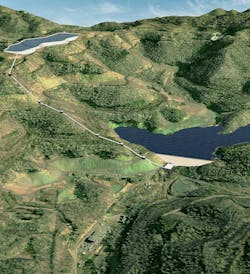Rye Development Converting Former Kentucky Coal Mine into 287 MW Pumped Storage Hydropower Facility
Rye Development will receive $81 million in funding from the Department of Energy (DOE) to convert former coal mine land in Bell County, Kentucky, into a closed-loop, 287 MW pumped storage hydropower (PSH) facility – the Lewis Ridge Project.
Pumped storage hydropower is a form of hydroelectric energy storage featuring two man-made reservoirs at different elevations that utilize gravity to produce energy. When energy demand is low, electricity is used to pump water to the upper reservoir, and when the grid needs more energy – such as during peak demand or extreme weather events – water flows to the lower reservoir to generate electricity.
Through this process, the Lewis Ridge Project will provide up to 671,700 MWh of clean electricity each year – enough to power 67,000 homes annually – and will have a daily energy storage/generation of 2,165 MWh with the ability to produce up to eight hours of dispatchable power when needed.
“This project is not only a significant investment in Kentucky; it’s an investment in strengthening our national electricity grid, helping to secure our energy future,” said Paul Jacob, CEO of Rye Development. “The Lewis Ridge Pumped Storage Project will protect against blackouts and brownouts while transforming a former mining site into a long-term economic engine for the region.”
Due to the decline of the coal industry, Bell County saw nearly 25% of its community relocate for other job opportunities, which has significantly decreased the area’s tax revenues over the past several decades. The Lewis Ridge Project will not only create close to 1,500 construction jobs and 30 operational jobs but also add millions in tax revenue to the community over the project’s expected 100-year lifetime.
“In close collaboration with our regional partners, this project demonstrates how we can breathe new life into former mining sites with proven technology built to last for more than a century,” said Sandy Slayton, VP of Rye Development. “This region and its skilled workforce are ready to create a new energy legacy in Eastern Kentucky.”
About the Author
Breanna Sandridge, Senior Editor
Breanna Sandridge is senior editor for EnergyTech and Microgrid Knowledge, both part of the energy group at Endeavor Business Media.
Prior to that, Breanna was managing editor for Machinery Lubrication and Reliable Plant magazines, both part of Noria Corp. She has two years experience covering the industrial sector.
She also is a 2021 graduate of Northeastern State University (Oklahoma) with a Bachelor's in English.
